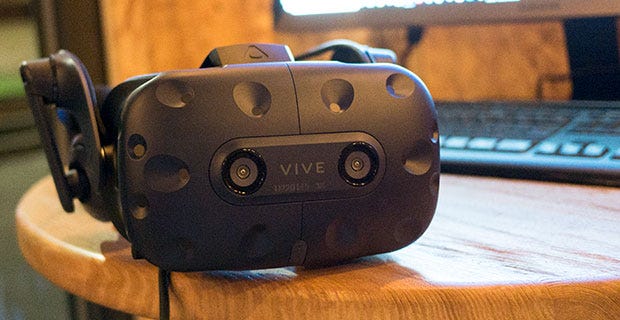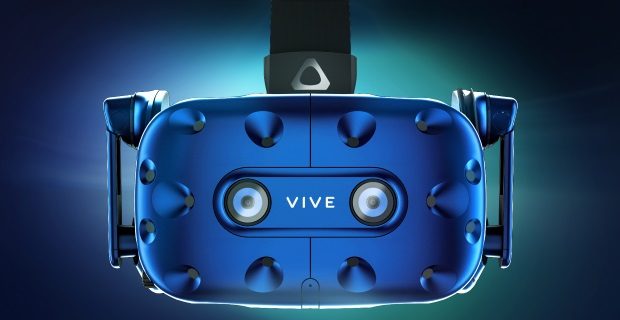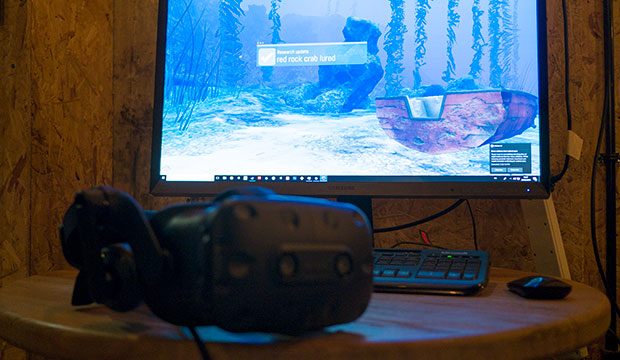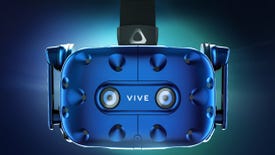Vive Pro tested: the visual upgrade VR desperately needed, but is it enough?
Is it really 78% better?
A short while ago, I got to stick my sweaty face into HTC's second generation PC VR headset, the Vive Pro, which was on show in the UK for the first time. The headset boasts a higher resolution and OLED displays, among other upgrades, and so the question is whether or not this can overcome VR's visual shortcomings and give the medium a much-needed second wind.
Well, it's definitely a big improvement - but that's also something of a double-edged sword.
I tested the Vive Pro with the suitably atmospheric undersea exploration game Operation Apex, made by UK developer Curiscope in partnership with Vive Studios. It was released last December, but has just released a big update which includes an appealing free-roam mode. Though it's just dandy on the original Vive, its grand seascapes and looming (but non-aggressive) sharks made a fine demo for this new version of the hardware.
The Vive Pro's resolution has jumped to 2880×1600 from the regular Vive's 2160 x 1200, which is a 78% increase in total pixel count which is, well, just a bunch of big numbers that aren't a terribly useful way of describing the difference in the flesh. I'll go with this: the Vive Pro, from a visual clarity and fidelity point of view, is pretty much what we all expected VR to be like back in 2015 or so, before the deflating reality of screen door effects and barely-legible text made itself known.
To put it another way, it's now pretty close to having your head encircled by 1080p monitors. Sure, it's not the blinding sharpness of a 1440p or 4K monitor, but my sense was that it was fit for purpose in a way that the gen.1 Vive and Ocuus Rift wasn't, not quite. No screen door. Eminently readable text. A problem solved.
The other big thing in terms of the raised resolution is something that doesn't happen in the headset. While waiting my turn to use the Vive Pro, I realised with a start after watching their in-game view on a nearby monitor for 10 minutes that I had been watching their in-game view on a nearby monitor for 10 minutes.
Which is to say, it was perfectly clear and watchable fullscreen on a 1080p display, where on a non-Pro Vive or Rift the traditional mirrored-screen experience is of either a uselessly tiny window or a smeary, blocky blur when made fullscreen. Outside of laughing at people swatting at imaginary flies, VR has not hitherto been much of a spectator sport. If the Vive Pro means that second-screen observation is now that much more feasible, that could change.
Of course, this may only heighten the growing sense that VR might only really make sense in public social situations. I had a ball with Operation Apex on the Vive Pro (and it was also the rare full analogue movement VR game that didn't leave me feeling at all queasy, as they've done smart things with the camera and controls) but I was playing at a roomscale in a bar. I simply don't have the space to do the same at home, at least not without burning most of my furniture. Same goes for the having an audience element.
That said, within moments of putting the Vive Pro on, my thoughts immediately turned to American Truck Simulator and Elite Dangerous. Though these are not thoroughbred VR games, they are the games that I've most often used a headset for, as both excel in their own way at atmosphere and vast spaces. The idea of getting to do that with far sharper vistas and much more legible text is deeply, deeply appealing, even though regular readers of the site will know that I've been suffering from a certain degree of VR ennui for some time.
With that in mind, I am very conscious that my mind was blown the first time I tried an original Vive, also in a large, public space with other people around, only to later find that the sense of awe soon wore off and the sense of disappointment about the visual fidelity mounted once I had one in my home.
Operation Apex running on the Vive Pro was a striking sight indeed, and gave me the strong impression that VR was a fixed problem from a display point of view. At the same time though, it still felt familiar enough that my jaw was nowhere as close to the floor as it was with that first Vive demo in 2015.
There was also a new downside. The clarity was great, but it also meant that, for instance, the odd low-poly rock or murky seaweed texture had nowhere to hide. This is not at all the fault of Operation Apex, but rather that the graphical horsepower requirements of VR even before the Vive Pro brought a 78% pixel count increase to the table are generally quite steep. Concessions need to be made in order to keep framerates high, which is why VR games don't look like The Witcher 3. Previously, the blurriness and grid effect of a Vive or Rift often masked how simple in-game models or lighting was, but 2880×1600 doesn't paper over as many cracks.
Don't get me wrong, I'll take clarity over concealment any day, particularly in terms of text and menus, plus there was definitely a heightened sense of depth and scale to Apex on the Vive Pro that I haven't felt with undersea games on the Vive. But, in a funny sort of way, it might be that VR games on the Pro reveal themselves as videogame-y in ways they didn't on the first generation of the hardware.
Speaking on hardware, in terms of the headset itself it's definitely recognisable as a Vive, but is larger (mostly due to integrated headphones) and generally a little bit more science-fictional in aesthetic. It felt a touch higher quality, and little things like a size adjustment dial instead of dicking about with velcro straps make a surprising amount of difference, and I should also say that it didn't feel any heavier that a normal Vive.
The motion controllers and tracking stations used in the demo were at least physically indiscernible from the Vive's, although a more knuckle-like, finger-monitoring Vive controller is due at some point.
The dismal reality of the trailing headset cable aslo remained - but this one was thinner than the Vive's, much more in keeping with the Rift's comparatively svelte umbilcal cord. The Vive Pro is due to have an add-on which lends it Intel's upcoming WiGig wireless display tech, but sadly that wasn't available in my demo session. If it works, coupled with the res hike the Pro is most definitely a massive upgrade.
But is it enough to put VR front and centre of things, at least from a gaming point of view? (I'm fully conscious the tech has many, potentially more successful, applications in other fields, and the Pro's sharp display will definitely make it more useful for, say, scientific simulations). Well, I can only speak for myself here. When I got home I looked at my 'old' Vive with a new dismay, but I didn't feel a burning need to own a Pro in the way I did that first Vive after my first experience on one.
Sure, I'd like the upgrade, particularly for the aforementioned truck and space sims, but not to the extent that I'm going to spend hundreds and hundreds of pounds on it. VR games themselves are so often a world of wavy-handed motion controls and minigames. Yes, there are jolly fascinating simulations of amazing sights, like Operation Apex, that I do want to experience more of, but I'm going to need to see many more meatier things from VR before I invest again. Maybe this new age of clear text and sharp edges means that can happen, but I know I'll want to wait and see.
Most of all though, my feeling is that had VR looked like it does on the Vive Pro first time around, things would be very different today.
The most pleasant Operation Apex is available for the HTC Vive now, and just put out a big update which adds a free-roam mode. There are no price or release date details for the Vive Pro as yet, but as I understand it we should be hearing more about it soon.
Oh! One more thing. When someone wearing a Vive Pro looks in your direction, the two camera lenses on the front really do make it look like some sinister, unblinking cartoon face is staring at you.

















